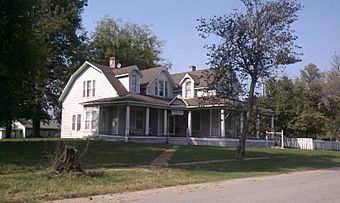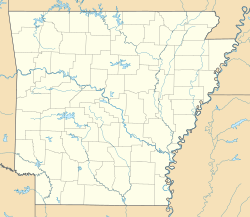Oliver House (Corning, Arkansas) facts for kids
Quick facts for kids |
|
|
Oliver House
|
|
 |
|
| Location | 203 W. Front St., Corning, Arkansas |
|---|---|
| Built | 1880 |
| Architectural style | Late Victorian |
| NRHP reference No. | 78000578 |
| Added to NRHP | December 8, 1978 |
The Oliver House is a historic home located at 203 West Front Street in Corning, Arkansas. It's a very old and special building that gives us a peek into the past. Built around 1880, it is one of the oldest buildings in Corning and has a unique design that makes it stand out.
Contents
The Oliver House: A Glimpse into History
The Oliver House is a two-and-a-half-story building made of wood. It has an interesting "L" shape. The main part of the house has a special roof called a gambrel roof, which has two different slopes on each side. Another section sticks out from the front, with a regular gable roof.
What Makes It Special?
A lovely porch wraps around the front and sides of the house. This porch has a hip roof, which means it slopes down on all sides. It is held up by smooth, round columns called Tuscan columns. Imagine sitting on this porch on a warm day!
Inside the Oliver House, you can still see much of the original wooden details. This includes two very fancy fireplace mantels, which are the decorative frames around the fireplaces. These details show the style of homes built a long time ago. The house was mostly finished in 1880, and only small changes were made around 1909.
Who Built and Lived Here?
The Oliver House was first built by a person named J. W. Harb. Not long after it was built, a doctor named J. L. Oliver Jr. bought the house. His son later ran a general store very close by, which would have been a busy place in the town back then. The Oliver family played a part in the early history of Corning.
Why Is It a Historic Place?
Because of its age, unique architecture, and connection to the early days of Corning, the Oliver House is considered very important. It was officially added to the National Register of Historic Places in 1978. This means it is recognized as a special building that should be preserved for future generations to learn from and enjoy.



